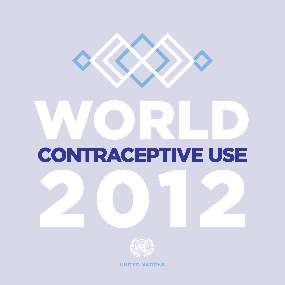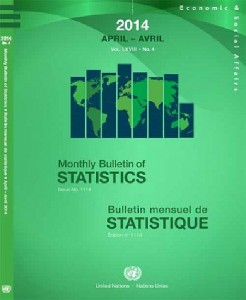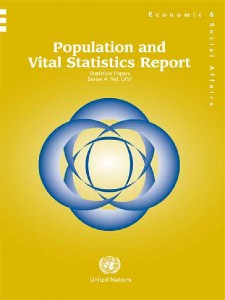World Economic Situation and Prospects as of mid-2014
 The latest updated global growth trajectory from the World Economic Situation and Prospects as of mid-2014 is 2.8 per cent in 2014 and 3.2 per cent in 2015, slightly lower than previously forecast in the World Economic Situation and Prospects 2014 released in January. The recovery in the developed economies will continue, but the growth prospects for the developing economies and the economies in transition have been revised downward, largely because of challenging economic and/or political conditions in a number of countries in these two latter groups.
The latest updated global growth trajectory from the World Economic Situation and Prospects as of mid-2014 is 2.8 per cent in 2014 and 3.2 per cent in 2015, slightly lower than previously forecast in the World Economic Situation and Prospects 2014 released in January. The recovery in the developed economies will continue, but the growth prospects for the developing economies and the economies in transition have been revised downward, largely because of challenging economic and/or political conditions in a number of countries in these two latter groups.
This mid-year update identifies a number of risks and uncertainties for the world economy, including international spill-overs from the future unwinding of the monetary easing by major developed economies; vulnerabilities of emerging economies on both external and domestic fronts; remaining fragilities in the euro area; unsustainable public finances in the longer run for many developed countries; and risks associated with geopolitical tensions.
World Contraceptive Use 2012
 Contraceptive prevalence and unmet need for family planning are key indicators for measuring improvements in access to reproductive health. The data set World Contraceptive Use 2012 includes country data as of July 2012 on contraceptive prevalence among married or in-union women for 194 countries or areas of the world and unmet need for family planning for 111 countries or areas of the world. Detailed trend data on contraceptive prevalence (total and by type of method) are available from 1950 to 2012. Unmet need for family planning data (total, spacing and limiting) are available from 1986 to 2012.
Contraceptive prevalence and unmet need for family planning are key indicators for measuring improvements in access to reproductive health. The data set World Contraceptive Use 2012 includes country data as of July 2012 on contraceptive prevalence among married or in-union women for 194 countries or areas of the world and unmet need for family planning for 111 countries or areas of the world. Detailed trend data on contraceptive prevalence (total and by type of method) are available from 1950 to 2012. Unmet need for family planning data (total, spacing and limiting) are available from 1986 to 2012.
The data set also includes new annual, model-based estimates and short-term projections from 1990 to 2015 of contraceptive prevalence (total, modern and traditional methods), unmet need for family planning (total and for modern methods) and related indicators. Median estimates with 80 per cent and 95 per cent uncertainty intervals are provided for 194 countries or areas of the world and for regions and development groups.
World Marriage Data 2012
 Comparable and up-to-date national data on the marital status of the population by age and sex for 221 countries and areas of the world are provided by World Marriage Data 2012 on four key indicators: Marital status of men and women, Currently married men and women, Ever married men and women and Singulate mean age at marriage (SMAM).
Comparable and up-to-date national data on the marital status of the population by age and sex for 221 countries and areas of the world are provided by World Marriage Data 2012 on four key indicators: Marital status of men and women, Currently married men and women, Ever married men and women and Singulate mean age at marriage (SMAM).
For each of these indicators and to the extent that data are available, data are presented for five reference dates: 1970, 1985, 1995, 2005 and the most recent data available. Major sources of data on marital status are censuses, sample surveys and national estimates based on population register data or on estimation methods using census data. Information on the definition of each indicator, data sources and criteria for data source selection, limitations and data coverage is provided in the metadata file. The data set presents data available as of January 2013.
Trends in International Migrant Stock: The 2013 Revision – Migrants by Age and Sex
For each of these data sets, estimates are presented for: 1990, 2000, 2010 and 2013. The estimates are based on official statistics on the foreign-born or the foreign population, classified by sex, and age. Most of the statistics utilized to estimate the international migrant stock were obtained from population censuses. Additionally, population registers and nationally representative surveys provided information on the number and composition of international migrants.
Adolescent Fertility since the International Conference on Population and Development (ICPD) in Cairo
This report presents new estimates of the levels and trends in adolescent fertility worldwide over the past 20 years and highlights key social and demographic factors underlying adolescent fertility, including early marriage, the timing and context of first sex, contraceptive use and education.
Estimates and Projections of Family Planning Indicators: 2013 Revision
This revision presents model-based estimates and projections of contraceptive prevalence, unmet need for family planning, total demand for family planning and percentage of demand for family planning that is satisfied among married or in-union women from 1970 to 2030. Median estimates with 80 per cent and 95 per cent uncertainty intervals are provided for 194 countries or areas of the world and for regions and development groups.
The revision updates the first release of model-based estimates in World Contraceptive Use 2012, incorporates recently available data and extends the projection period from 2015 to 2030. Model results are as of May 2013.
World Contraceptive Patterns 2013 Wall chart
As part of Millennium Development Goal 5 to improve maternal health, Governments committed themselves to achieve, by 2015, universal access to reproductive health (Target 5.B). This wall chart presents the latest data available on two of the indicators under this target: contraceptive prevalence and unmet need for family planning. Estimates of specific contraceptive methods used in major areas and sub-regions of the world are also presented.
Statistical compilations
Monthly Bulletin of Statistics and MBS Online

The Monthly Bulletin of Statistics presents current economic and social statistics for more than 200 countries and territories of the world. It contains over 50 tables of monthly and/or bimonthly, quarterly and annual data on a variety of subjects illustrating important economic trends and developments, including population, prices, employment and earnings, energy, manufacturing, transport, construction, international merchandise trade and finance.
Vol. LXVIII – No. 4, April 2014
In addition to the regular recurrent monthly tables, this issue includes quarterly and bimonthly tables: Retail price indices relating to living expenditures of United Nations officials; Civil aviation traffic: passenger-km and cargo net ton-km; Total exports and imports by countries or areas: volume, unit value, terms of trade and purchasing power of exports, in US dollars.
Population and Vital Statistics Report, Volume 66
 The Population and Vital Statistics Report presents most recent data on population size (total, male and female) from the latest available census of the population, national official population estimates and the number and rate (births, deaths and infant deaths) for the latest available year within the past 15 years. It also presents United Nations estimates of the mid-year population of the world, and its major areas and regions.
The Population and Vital Statistics Report presents most recent data on population size (total, male and female) from the latest available census of the population, national official population estimates and the number and rate (births, deaths and infant deaths) for the latest available year within the past 15 years. It also presents United Nations estimates of the mid-year population of the world, and its major areas and regions.
This report, in this format, is published once a year, while the electronic version is updated every two weeks at the UNSD website. The report presents data on total, female and male population counts from the most recent population census, population estimates and number and rates of vital events – births, deaths and infant deaths – for all the countries of the world. These data are presented as reported by national statistical authorities to the United Nations Demographic Yearbook.
Outreach material
Sustainable Development in Action – Issue 5, Volume 2
The latest issue, published by UN DESA’s Division for Sustainable Development, highlights among others, the High-level Political Forum on sustainable development. The newsletter aims to feature the work carried out by Member States, United Nations system, Major Groups and other relevant stakeholders in implementing sustainable development and leading the way to the Future We Want.
Youth Flash Newsletter
Published by UN DESA’s Division for Social Policy and Development Focal Point on Youth, the May issue is available online including a feature story providing a youth perspective to why inter-generational ties are important. The newsletter is prepared with input from UN offices, agencies, and from youth organizations around the world.
